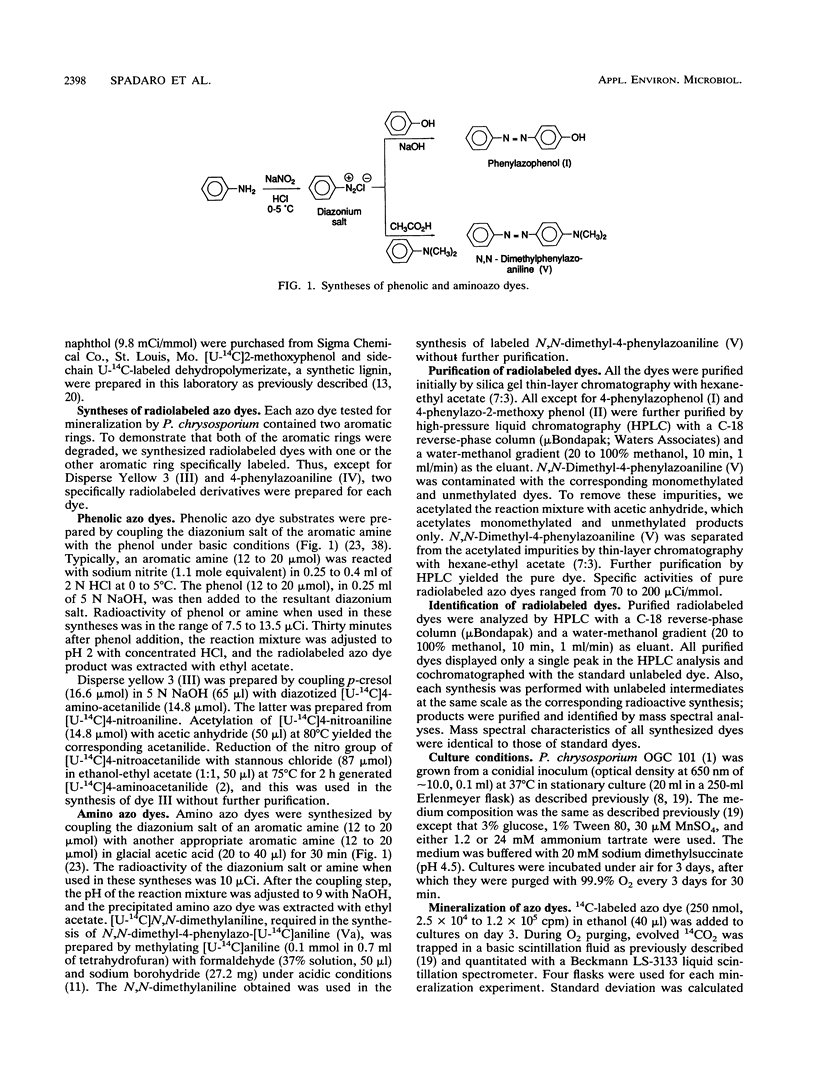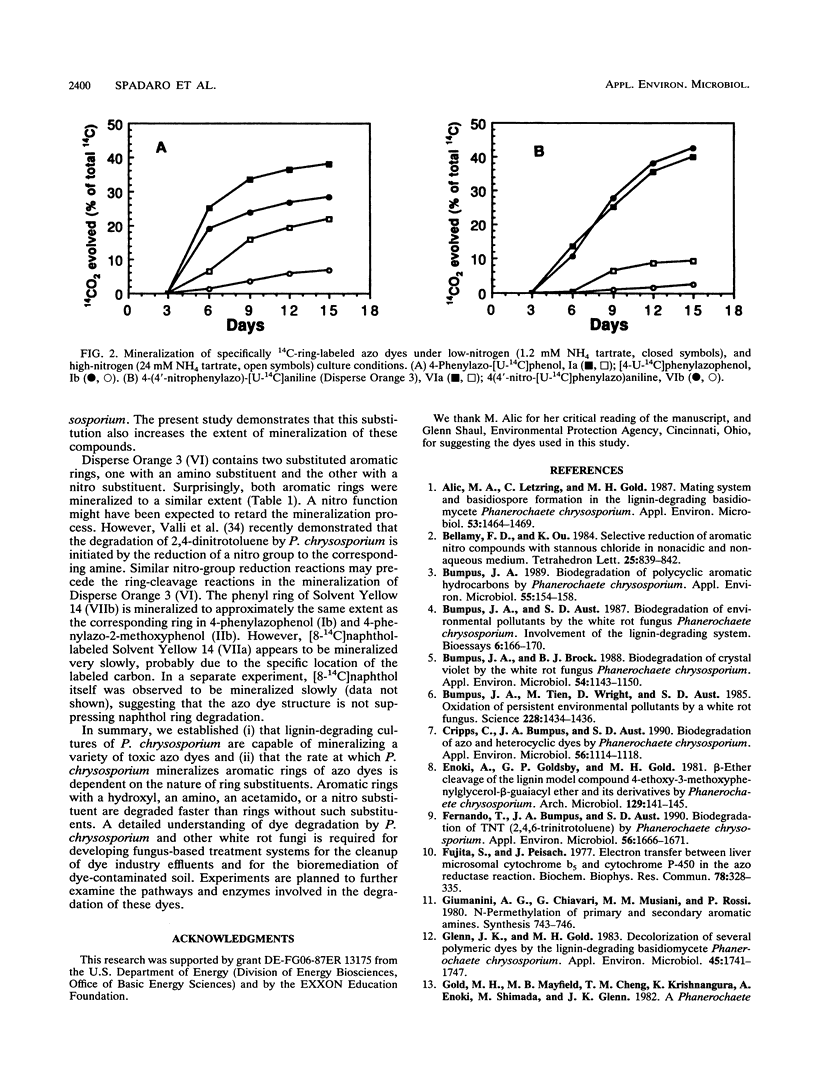Abstract
Under nitrogen-limiting, secondary metabolic conditions, the white rot basidiomycete Phanerochaete chrysosporium extensively mineralized the specifically 14C-ring-labeled azo dyes 4-phenylazophenol, 4-phenylazo-2-methoxyphenol, Disperse Yellow 3 [2-(4'-acetamidophenylazo)-4-methylphenol], 4-phenylazoaniline, N,N-dimethyl-4-phenylazoaniline, Disperse Orange 3 [4-(4'-nitrophenylazo)-aniline], and Solvent Yellow 14 (1-phenylazo-2-naphthol). Twelve days after addition to cultures, the dyes had been mineralized 23.1 to 48.1%. Aromatic rings with substituents such as hydroxyl, amino, acetamido, or nitro functions were mineralized to a greater extent than unsubstituted rings. Most of the dyes were degraded extensively only under nitrogen-limiting, ligninolytic conditions. However, 4-phenylazo-[U-14C]phenol and 4-phenylazo-[U-14C]2-methoxyphenol were mineralized to a lesser extent under nitrogen-sufficient, nonligninolytic conditions as well. These results suggest that P. chrysosporium has potential applications for the cleanup of textile mill effluents and for the bioremediation of dye-contaminated soil.
Full text
PDF




Selected References
These references are in PubMed. This may not be the complete list of references from this article.
- Alic M., Letzring C., Gold M. H. Mating System and Basidiospore Formation in the Lignin-Degrading Basidiomycete Phanerochaete chrysosporium. Appl Environ Microbiol. 1987 Jul;53(7):1464–1469. doi: 10.1128/aem.53.7.1464-1469.1987. [DOI] [PMC free article] [PubMed] [Google Scholar]
- Bumpus J. A. Biodegradation of polycyclic hydrocarbons by Phanerochaete chrysosporium. Appl Environ Microbiol. 1989 Jan;55(1):154–158. doi: 10.1128/aem.55.1.154-158.1989. [DOI] [PMC free article] [PubMed] [Google Scholar]
- Bumpus J. A., Brock B. J. Biodegradation of crystal violet by the white rot fungus Phanerochaete chrysosporium. Appl Environ Microbiol. 1988 May;54(5):1143–1150. doi: 10.1128/aem.54.5.1143-1150.1988. [DOI] [PMC free article] [PubMed] [Google Scholar]
- Bumpus J. A., Tien M., Wright D., Aust S. D. Oxidation of persistent environmental pollutants by a white rot fungus. Science. 1985 Jun 21;228(4706):1434–1436. doi: 10.1126/science.3925550. [DOI] [PubMed] [Google Scholar]
- Cripps C., Bumpus J. A., Aust S. D. Biodegradation of azo and heterocyclic dyes by Phanerochaete chrysosporium. Appl Environ Microbiol. 1990 Apr;56(4):1114–1118. doi: 10.1128/aem.56.4.1114-1118.1990. [DOI] [PMC free article] [PubMed] [Google Scholar]
- Fernando T., Bumpus J. A., Aust S. D. Biodegradation of TNT (2,4,6-trinitrotoluene) by Phanerochaete chrysosporium. Appl Environ Microbiol. 1990 Jun;56(6):1666–1671. doi: 10.1128/aem.56.6.1666-1671.1990. [DOI] [PMC free article] [PubMed] [Google Scholar]
- Fujita S., Peisach J. Electron transfer between liver microsomal cytochrome b5 and cytochrome P-450 in the azo reductase reaction. Biochem Biophys Res Commun. 1977 Sep 9;78(1):328–335. doi: 10.1016/0006-291x(77)91258-x. [DOI] [PubMed] [Google Scholar]
- Glenn J. K., Gold M. H. Decolorization of Several Polymeric Dyes by the Lignin-Degrading Basidiomycete Phanerochaete chrysosporium. Appl Environ Microbiol. 1983 Jun;45(6):1741–1747. doi: 10.1128/aem.45.6.1741-1747.1983. [DOI] [PMC free article] [PubMed] [Google Scholar]
- Haug W., Schmidt A., Nörtemann B., Hempel D. C., Stolz A., Knackmuss H. J. Mineralization of the sulfonated azo dye Mordant Yellow 3 by a 6-aminonaphthalene-2-sulfonate-degrading bacterial consortium. Appl Environ Microbiol. 1991 Nov;57(11):3144–3149. doi: 10.1128/aem.57.11.3144-3149.1991. [DOI] [PMC free article] [PubMed] [Google Scholar]
- Huang M. T., Miwa G. T., Lu A. Y. Rat liver cytosolic azoreductase. Purification and characterization. J Biol Chem. 1979 May 25;254(10):3930–3934. [PubMed] [Google Scholar]
- Kirk T. K., Farrell R. L. Enzymatic "combustion": the microbial degradation of lignin. Annu Rev Microbiol. 1987;41:465–505. doi: 10.1146/annurev.mi.41.100187.002341. [DOI] [PubMed] [Google Scholar]
- McCann J., Ames B. N. Detection of carcinogens as mutagens in the Salmonella/microsome test: assay of 300 chemicals: discussion. Proc Natl Acad Sci U S A. 1976 Mar;73(3):950–954. doi: 10.1073/pnas.73.3.950. [DOI] [PMC free article] [PubMed] [Google Scholar]
- Mileski G. J., Bumpus J. A., Jurek M. A., Aust S. D. Biodegradation of pentachlorophenol by the white rot fungus Phanerochaete chrysosporium. Appl Environ Microbiol. 1988 Dec;54(12):2885–2889. doi: 10.1128/aem.54.12.2885-2889.1988. [DOI] [PMC free article] [PubMed] [Google Scholar]
- Paszczynski A., Crawford R. L. Degradation of azo compounds by ligninase from Phanerochaete chrysosporium: involvement of veratryl alcohol. Biochem Biophys Res Commun. 1991 Aug 15;178(3):1056–1063. doi: 10.1016/0006-291x(91)90999-n. [DOI] [PubMed] [Google Scholar]
- Rafii F., Franklin W., Cerniglia C. E. Azoreductase activity of anaerobic bacteria isolated from human intestinal microflora. Appl Environ Microbiol. 1990 Jul;56(7):2146–2151. doi: 10.1128/aem.56.7.2146-2151.1990. [DOI] [PMC free article] [PubMed] [Google Scholar]
- Tarpley W. G., Miller J. A., Miller E. C. Adducts from the reaction of N-benzoyloxy-N-methyl-4-aminoazobenzene with deoxyguanosine or DNA in vitro and from hepatic DNA of mice treated with N-methyl- or N,N-dimethyl-4-aminoazobenzene. Cancer Res. 1980 Jul;40(7):2493–2499. [PubMed] [Google Scholar]
- Valli K., Brock B. J., Joshi D. K., Gold M. H. Degradation of 2,4-dinitrotoluene by the lignin-degrading fungus Phanerochaete chrysosporium. Appl Environ Microbiol. 1992 Jan;58(1):221–228. doi: 10.1128/aem.58.1.221-228.1992. [DOI] [PMC free article] [PubMed] [Google Scholar]
- Valli K., Gold M. H. Degradation of 2,4-dichlorophenol by the lignin-degrading fungus Phanerochaete chrysosporium. J Bacteriol. 1991 Jan;173(1):345–352. doi: 10.1128/jb.173.1.345-352.1991. [DOI] [PMC free article] [PubMed] [Google Scholar]
- Zimmermann T., Kulla H. G., Leisinger T. Properties of purified Orange II azoreductase, the enzyme initiating azo dye degradation by Pseudomonas KF46. Eur J Biochem. 1982 Dec;129(1):197–203. doi: 10.1111/j.1432-1033.1982.tb07040.x. [DOI] [PubMed] [Google Scholar]


